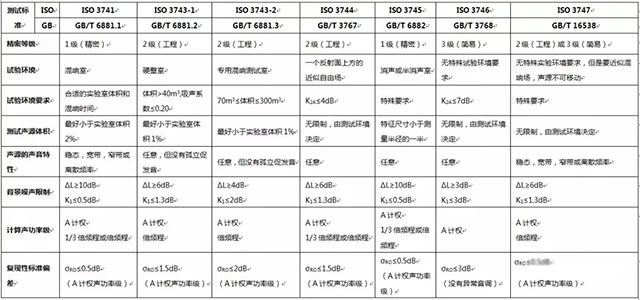Sound power test method
From the definition of sound power, we can know that sound power can not be directly tested, it is necessary to calculate the sound power through re-calculation. Generally, the sound power (level) of the sound source is calculated by the sound pressure method and the sound intensity method.
Sound pressure method is a traditional sound power test method, which is generally required to be carried out in a specific acoustic environment, with high test accuracy, and has no requirement on the sound characteristics of the sound source. The sound intensity method can be tested in the general acoustic environment, which can eliminate the influence of external interference on the test, and does not require a high acoustic environment. It is suitable for the measurement of the sound source work site, but only for the steady state sound source.
Whether it is sound pressure method or sound intensity method, it is necessary to have a measuring surface of the measured sound source. In addition to the measured sound source, there can be no other sound source or sound absorber in the measuring surface, and the distance between the measuring surface and the measured sound source should be moderate.
Sound pressure method is used to measure sound power
All kinds of characteristic noise can be measured by sound pressure method. Various types of characteristic noise include: steady state, unsteady state, wide band, narrow band, discrete frequency and pulse noise.
Among them, the sound pressure method to test the sound power standard summary, see the table below

*K2A - The A-weighted correction for the effect of the acoustic reflection and absorption of the test environment on the surface sound pressure level; ΔL - the sound level difference between the background noise and the octave band of the measured noise source; K1 - Correction for the effect of background noise on surface sound pressure level.
ISO 3745 test standard
ISO 3745 is one of the sound pressure methods for testing the sound power level and sound energy level of a noise source, which requires the sound source to be installed in an anechoic chamber or semi-anechoic chamber with specified acoustic characteristics [2]. Test accuracy level is 1 (precision method). The measured sound power level The sound energy level contains corrections to take into account differences between the meteorological conditions during the measurement and the reference meteorological conditions.
In general, the frequency range measured by the ISO 3745 standard is 1/3 octaves of the center frequency of 100Hz to 10000Hz. In each frequency band, all measuring points or moving paths, the sound pressure level difference between the background noise and the measured noise source should be at least 6dB; For the center frequency from 250Hz to 5000Hz 1/3 octave band sound pressure level difference of at least 10dB.
Spherical measurement is used in anechoic chamber, and the center of the measured sphere should be consistent with the acoustic center of the measured sound source (acoustic center known) or geometric center (acoustic center unknown). The spherical center of the hemispherical surface shall be on the ground of the semi-anechoic chamber and vertically below the acoustic center (known acoustic center) or geometric center (unknown acoustic center) of the measured sound source. The measurement radius of the spherical and hemispherical surfaces shall meet the following requirements:

* d0 - the characteristic size of the measured sound source; λ - the wavelength of the lowest frequency measured in the frequency range; At present, the ISO 3745 test standard is widely used in the laboratory to test the sound power of sound sources. For example, the upcoming "Electric Power System Noise Measurement Method for Electric Vehicles" in the automotive industry clearly specifies the need for IS0 3745(GB/T 6882) in the measurement method.



